This Saturday, La Liga will be host to a potentially season-defining battle between Real Madrid and Barcelona. Of course, Atletico Madrid are still in the driver’s seat but it’s difficult to escape the notion of El Clásico deciding the next champion of Spain. Having beaten Liverpool mid-week, Los Blancos will be eager to do the same to the Blaugranas and Barcelona will want to continue their incredible unbeaten streak in the domestic league in 2021.
This tactical analysis will be a preview of the clash, highlighting both teams’ tactics and potential key points heading into the game. At the end of the analysis, we’ll also try to give you our final predictions, if that’s even possible for a huge match like this one.
Lineups
This is a difficult lineup to pick because we’ve seen Real Madrid available personnel play well in both the 4-3-3 and 3-5-2. Looking at previous Clásicos, Zidane has often inserted an additional midfielder into the starting XI in an effort to control the centre of the pitch.
Despite the temptation to set the team out in a 3-5-2, rotating one of two players from the group that face Liverpool, look for Zidane to stick with an “if it ain’t broke, don’t fix it” approach. That applies not only to the 4-3-3, but to the starting XI as well.
Should he stick with the same starting XI, Thibaut Courtois will feature in goal with Ferland Mendy and Lucas Vázquez as his outside-back with Nacho Fernández and Éder Militão in the centre. The midfield trio will certainly be Casemiro, Toni Kroos and Luka Modrić. Up top, from right to left, the Real Madrid forward line will likely feature Marco Asensio, Karim Benzema, and Vinícius Júnior. If fit, Eden Hazard and Dani Carvajal could earn minutes, as should Federico Valverde. The Uruguayan and Rodrygo Goes could also find their way into the starting XI in place of Asensio.
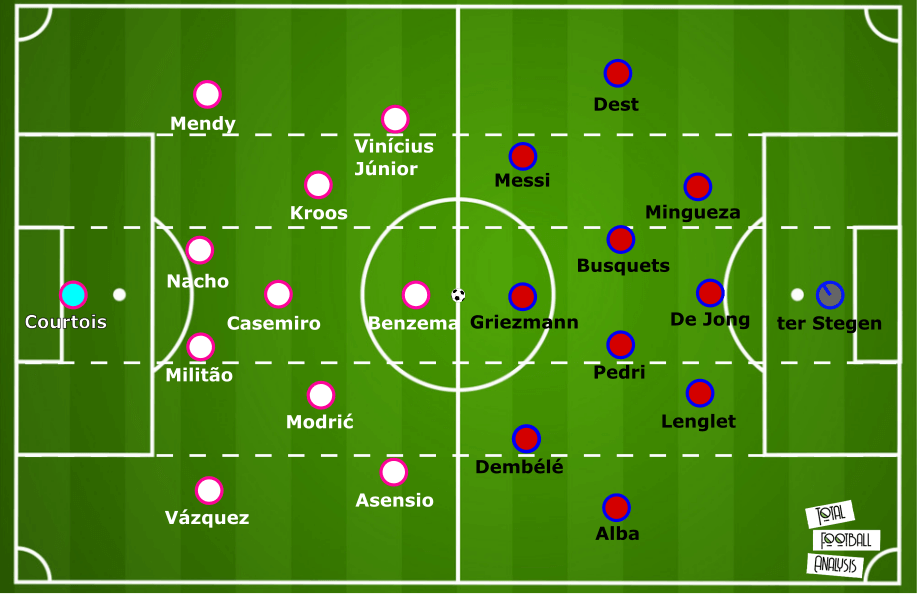
One of Koeman’s major changes at Barcelona in the last weeks has been a shift away from their traditional 4-3-3 formation. The Catalans are now often deployed in a 3-4-3/ 3-5-2 system, which has done wonders to reinvigorate the squad. It is, therefore, to be expected that we see them face Real Madrid in that same structure.
There are, however, some questions that need to be answered. We still don’t know how fit will Gerard Piqué be come Saturday nor what the rest of the backline might look like. Ronald Araújo is another question mark for the backline and despite potentially being the most reliable of Barcelona defenders, he may start on the bench too.
Koeman is likely to deploy Frenkie de Jong in the libero role between Clément Lenglet and Óscar Mingueza, just as was the case against Real Valladolid on Monday. We’ll discuss the pros of that strategy further down the line of this tactical analysis. The rest of the squad picks itself with Marc-André ter Stegen in goal and Jordi Alba and Sergiño Dest as wingbacks flanking Pedri and Sergio Busquets.
Higher up, Antoine Griezmann, Lionel Messi and Ousmane Dembélé complete the gala XI.
The De Jong dilemma
Ever since his arrival, De Jong has been looking for his ideal role in this Barcelona squad. We’ve seen him in a double pivot, a single pivot, a no.8 or even drifting wide and bursting forward beyond opposition lines. Now, however, the Dutchman is reviving the libero role at the Catalan giants.
De Jong is a naturally press-resistant midfielder with great vision and incredible ability to carry the ball through his progressive runs. That makes him the perfect candidate to complete the back three Koeman seems to prefer at the moment.
But of course, that is not the only option for Barcelona as De Jong can easily slot in the midfield three, offering those invaluable penetrating runs and a surprising presence in the box. While not completely nullified, this tendency is somewhat lessened by his deployment in the libero role. On the other hand, removing De Jong from midfield could play right into Real Madrid’s hands, seeing how the key to winning the last Clásico was in dominating the centre of the pitch where Casemiro, Luka Modrić and Toni Kroos tend to pull the strings.
However, we do believe that should Piqué not start the match on Saturday, we’ll see De Jong in the backline. Such a system is excellent against high-pressing teams like Real Madrid and given Los Blancos’ shakiness in that department, this could indeed be Barcelona’s chance to strike. So how exactly does De Jong do that?
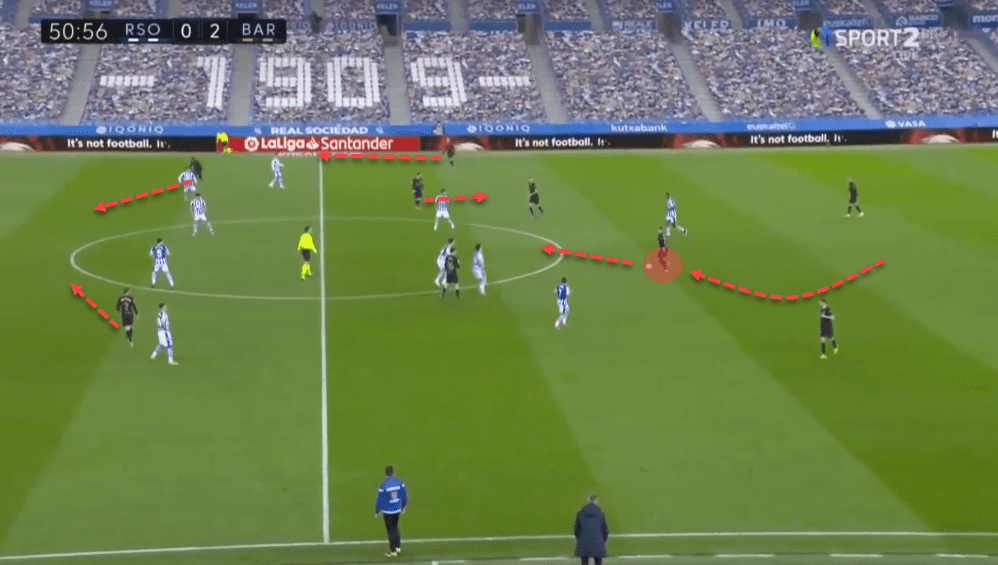
In the image above, you can see how a fairly standard sequence looks like. De Jong will take the ball in the backline and then proceed to beat his marker and advance up the pitch. This is very effective against high-pressing squads because it suddenly opens up a lot of space to be exploited by the attackers after bypassing the first line.
Above, De Jong heads towards the centre of the pitch and suddenly has multiple options to choose from. But the most important thing for Barcelona in any game, not just against Real Madrid, is to find the priority targets in space. That could be the likes of Messi, Griezmann or Dembélé, just as is the case in our example.
In the end, the Dutchman combines with Leo and Barcelona continue their assault. The next image is very similar and shows how that connection is formed again. De Jong burst past Alexander Isak and finds Griezmann who’s dropping through his half-space channel.
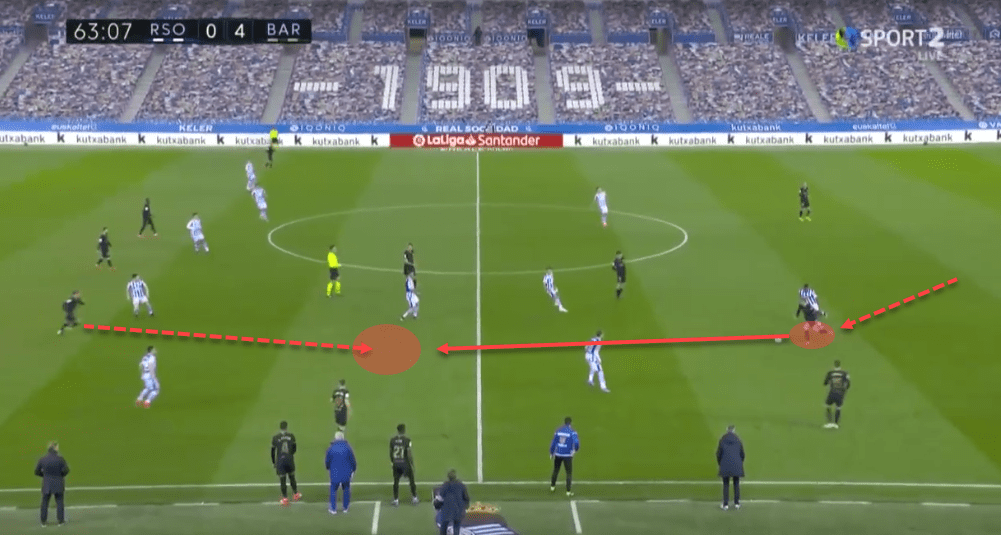
This could indeed be the key to finding priority targets beyond Real Madrid’s aggressive unit. But we mustn’t forget that such runs from the deep also attract markers and force the defenders out of their position. When a centre-back charges forward, it’s bound to grab the attention of the defending team.
Barcelona and De Jong in particular have the skill to make use of that to free up other areas of the pitch and once again, access their main attacking forces. In the following image, you can see De Jong is being collapsed upon by three different players following one of his signature runs from the backline.
This, in turn, opens the space towards Messi and forces other Paris Saint-Germain players to step out of their positions to plug the holes. Inevitably, that once again creates space elsewhere as the opposition is constantly being moved around the pitch.
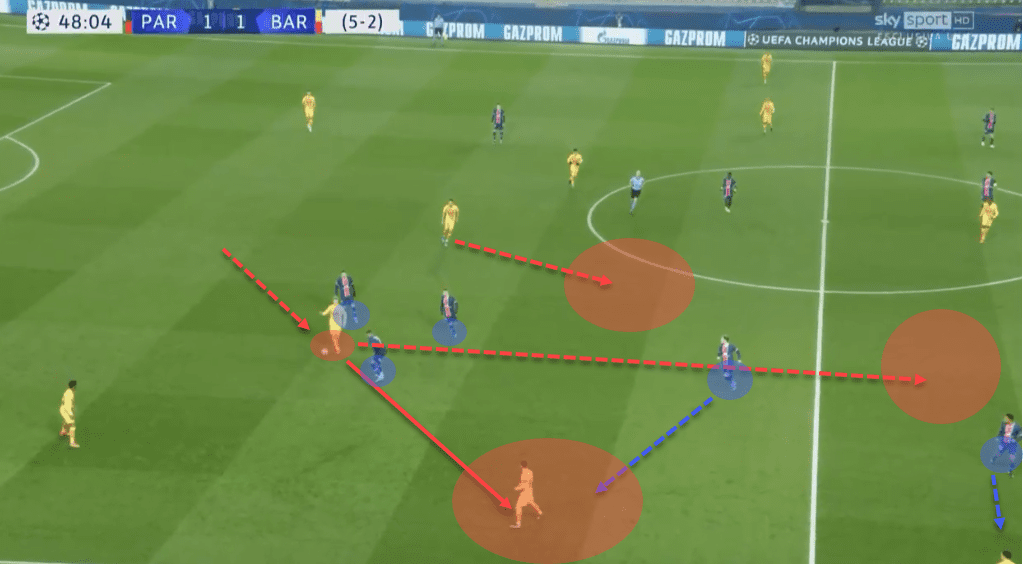
But probably the most important question is how can Barcelona ensure they control the middle of the pitch without De Jong in that midfield trident. He may be a centre-back on paper but Barcelona will often use his runs to create superiorities and open passing channels higher up the pitch.
Let’s take a look at a couple of examples below. In the first one, by moving from the centre-back position into the pivot role, De Jong exploits unmarked space in PSG’s defensive structure.
By joining Pedri and Busquets, the Dutchman helps to overload the opposition’s second line and the Catalans can progress up the pitch.
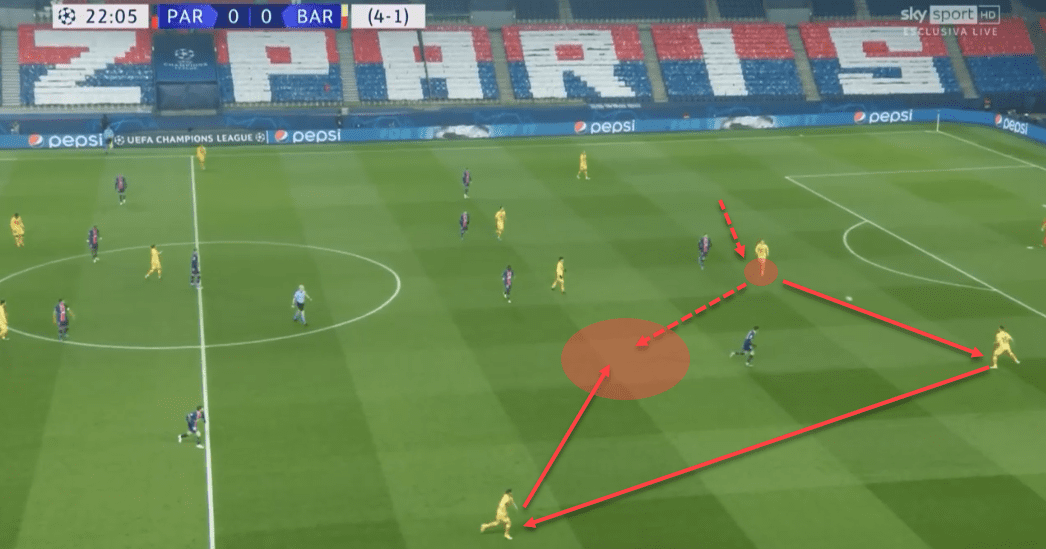
This is one of the ways Barcelona can still look to dominate the middle of the park without having three midfielders against Real Madrid’s own three. Our final example, once again against PSG, can demonstrate that one more time.
We know that both Messi and Griezmann like to drop deeper, which is another way of creating superiorities, and due to their gravity, it creates space elsewhere, just as De Jong’s runs do.
Here, Barcelona use that combined with the Dutchman’s willingness to step up the pitch to once again exploit the newfound pocket of space that creates an overload and progresses the ball towards the opposition’s half.
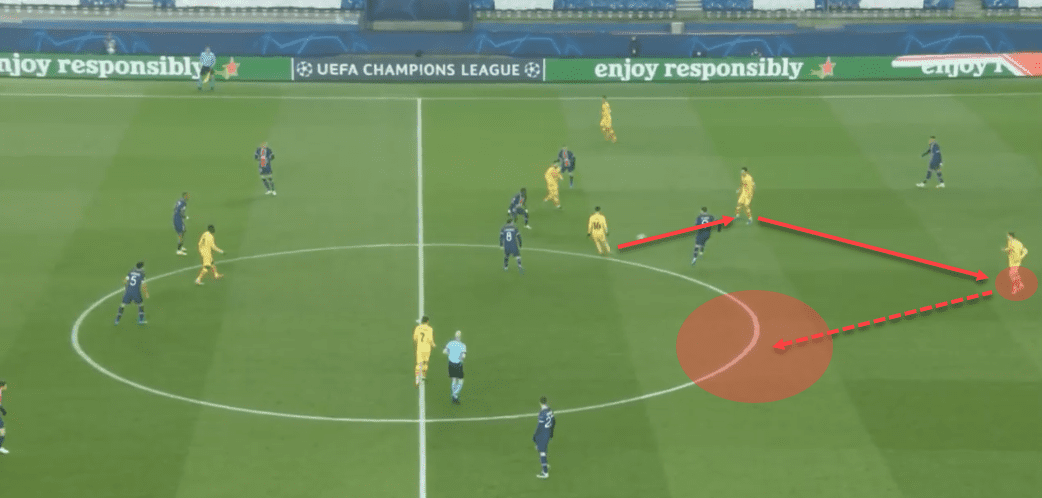
Barcelona’s pressing
One of the main aspects that Barcelona have improved under Koeman is their pressing. A part of that stems from the newly introduced system but also through well-defined roles. The Catalans now deploy a heavy man-marking pressing scheme that aims to suffocate opposition in the first phase of their build-up.
The 3-5-2 system with two wingbacks means Barcelona can either match the opposition’s backline in numbers or simply force them to drop more players deep onto the pitch, making them overcommit just to get out of their backyard.
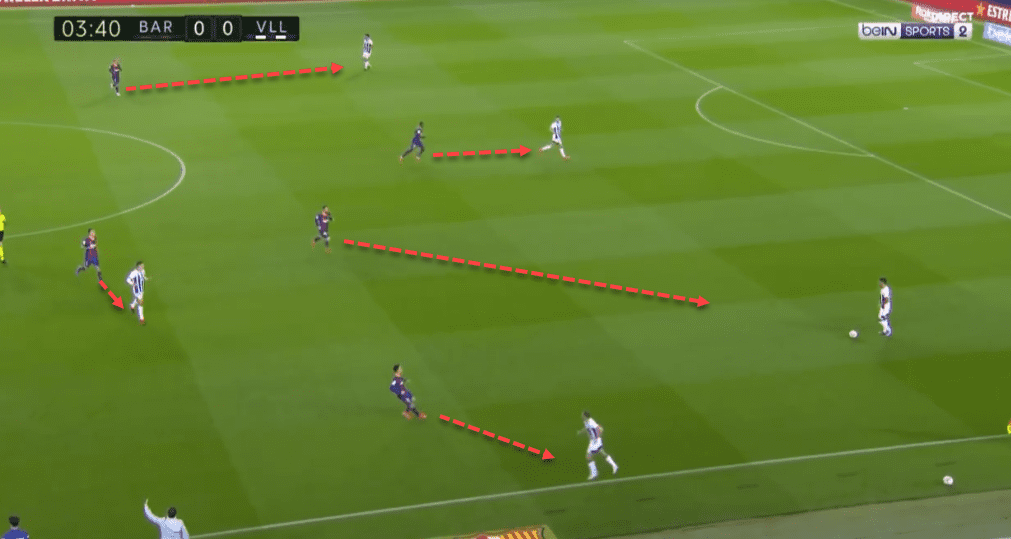
In the image above, you can see a fairly standard pressing structure and tactics Koeman likes to use. Barcelona will try to match or overload the attacking team on their half of the pitch by giving the wingbacks freedom to push up higher. This is nothing particularly new but the introduction of a back three means there’s more protection behind their backs now.
As a result, the Catalans are showing more calculated aggression and we are likely to see them do the same against Real Madrid on Saturday. Here’s another example of those same tactics being deployed against Huesca.
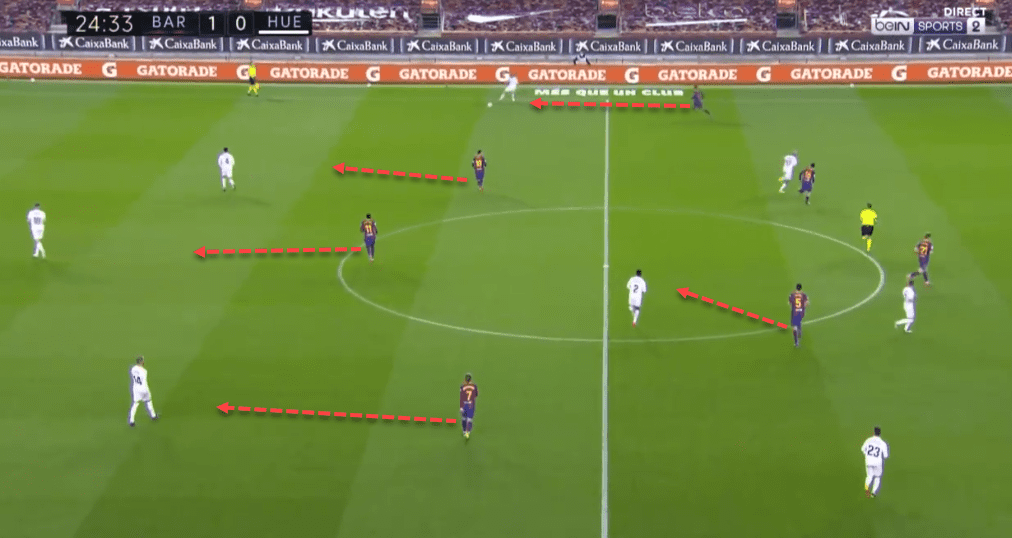
However, their counter-pressing still needs work and they seem to be liable to quick switches, especially from the opposition’s left to right where Alba sometimes forgets to mark his man. Seeing how their next opponent has players like Kroos and Modrić who can make those clean switches, as we saw against Liverpool mid-week, Koeman will have to address this problem going into the game.
Real Madrid’s build-out to direct attacks
After dismantling Liverpool midweek, Real Madrid must quickly turn their attention to their biggest La Liga match of this season. sitting three points behind Atlético Madrid and two behind Barcelona, dropping points could prove fatal in their title defence.
If there is a positive in playing Barcelona on either side of two Liverpool matchups, it’s that the two teams utilise very similar tactics. Like Liverpool, expect Barcelona to come out in a high press, challenging Real Madrid’s ball progression from deep in their end. Much like the Liverpool game, expect Zidane to trust Courtois, the centrebacks and his midfielders to protect the ball and play out of Barcelona’s press. In fact, expect Real Madrid to emphasise building out of the back, inviting Barcelona to move higher up the pitch while using a high central overload of the forwards to occupy the four members of Barcelona’s backline, clearing the wings for Mendy and Vázquez.
Courtois, in particular, was critical to the team’s success, showcasing his growing confidence with the ball at his feet. One of the reasons Real Madrid will use Courtois in the centrebacks to structure the build-out is to buy time and space for Kroos to receive and dictate play.
As Real Madrid progress into the middle third, their attacking structure will become very clear. Kroos and Casemiro will swap roles with the German dropping deep, often between the two centrebacks, while the Brazilian pushes higher up the pitch to offer an outlet and participate in the counterpress when possession is lost. Los Blancos will leave just Vázquez and Mendy high in the wings, allowing them to take advantage of the space created by the three forwards.
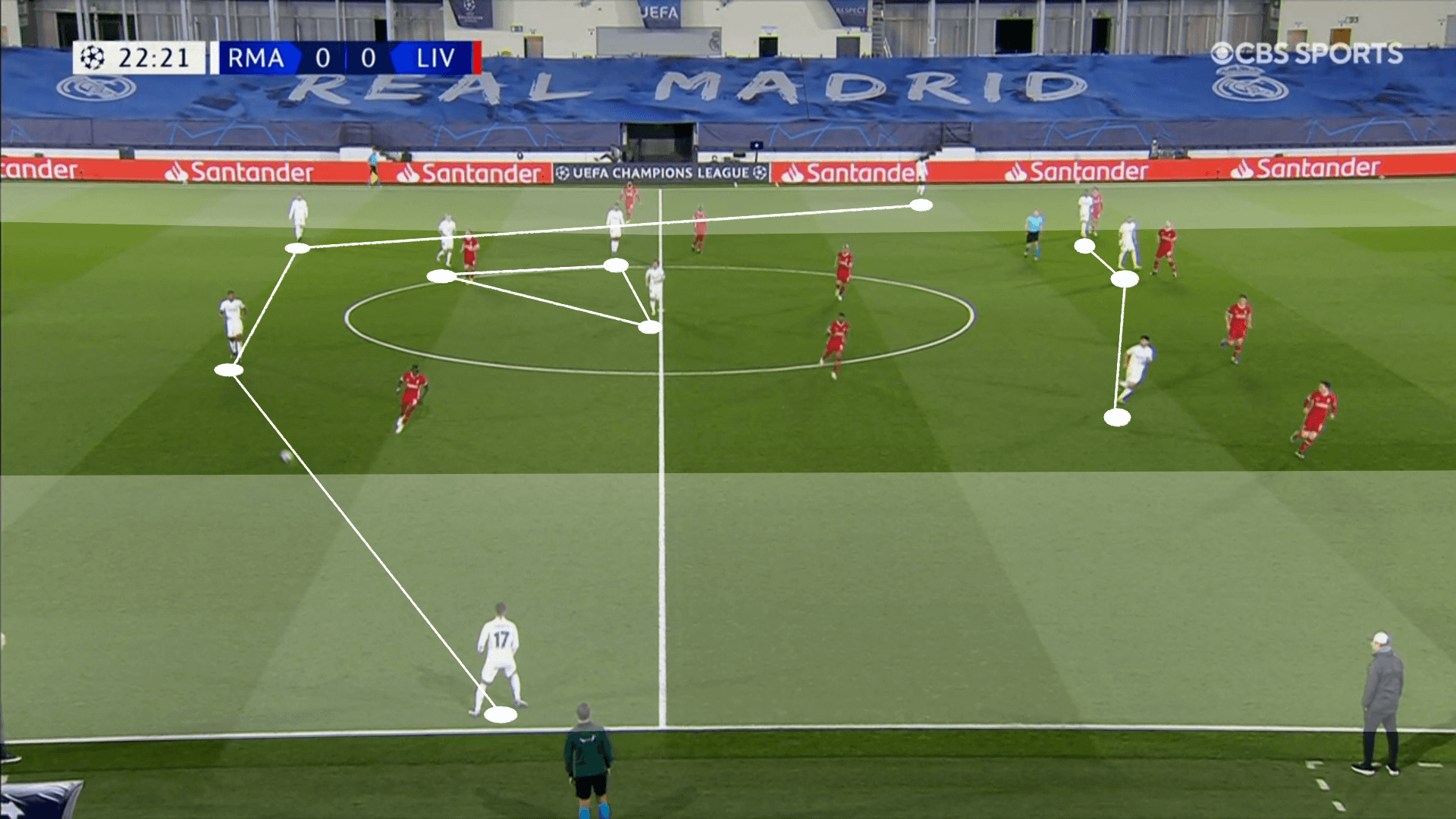
As the ball reaches the wings, that’s when we’re likely to see the forwards coordinate their movements so that one makes a run into the half space while the other moves into a more central position, either to draw the cover defender to himself so that the pass into the half space carries more of a threat or to offer a central outlet, which they can use to set the ball into the midfielders or play directly into the third runner.
The last time these two teams met, the first goal of the game was produced from this exact setup. A central overload saw Asensio leave the right half space, making a run into the right-wing. As Lenglet went with him, space opened up for Benzema to receive in the right half space. Valverde checked towards the ball, just underneath Benzema as well, which is critical to this goal.
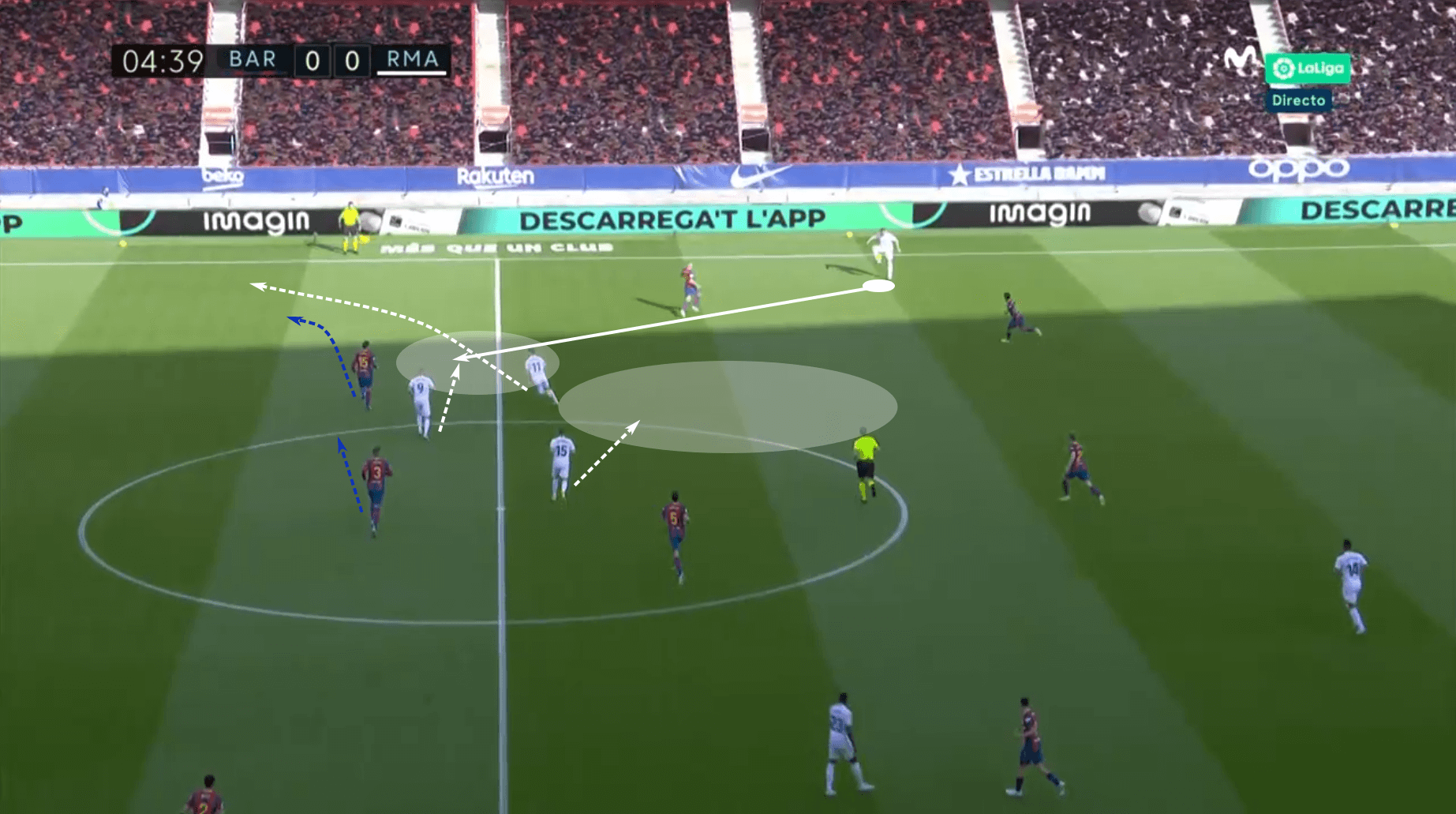
As Benzema took an aggressive touch in the direction of Asensio, he created a 2v2 against the two Barcelona centrebacks. With Piqué overcommitting to his left, the central channel was wide open. Neither Busquets nor Dest covered for him, signalling Valverde to make a hard run through the central channel. Benzema picked out the young Uruguayan, slotting him behind the Barcelona backline and setting him up for an excellent finish, giving Madrid an early lead.
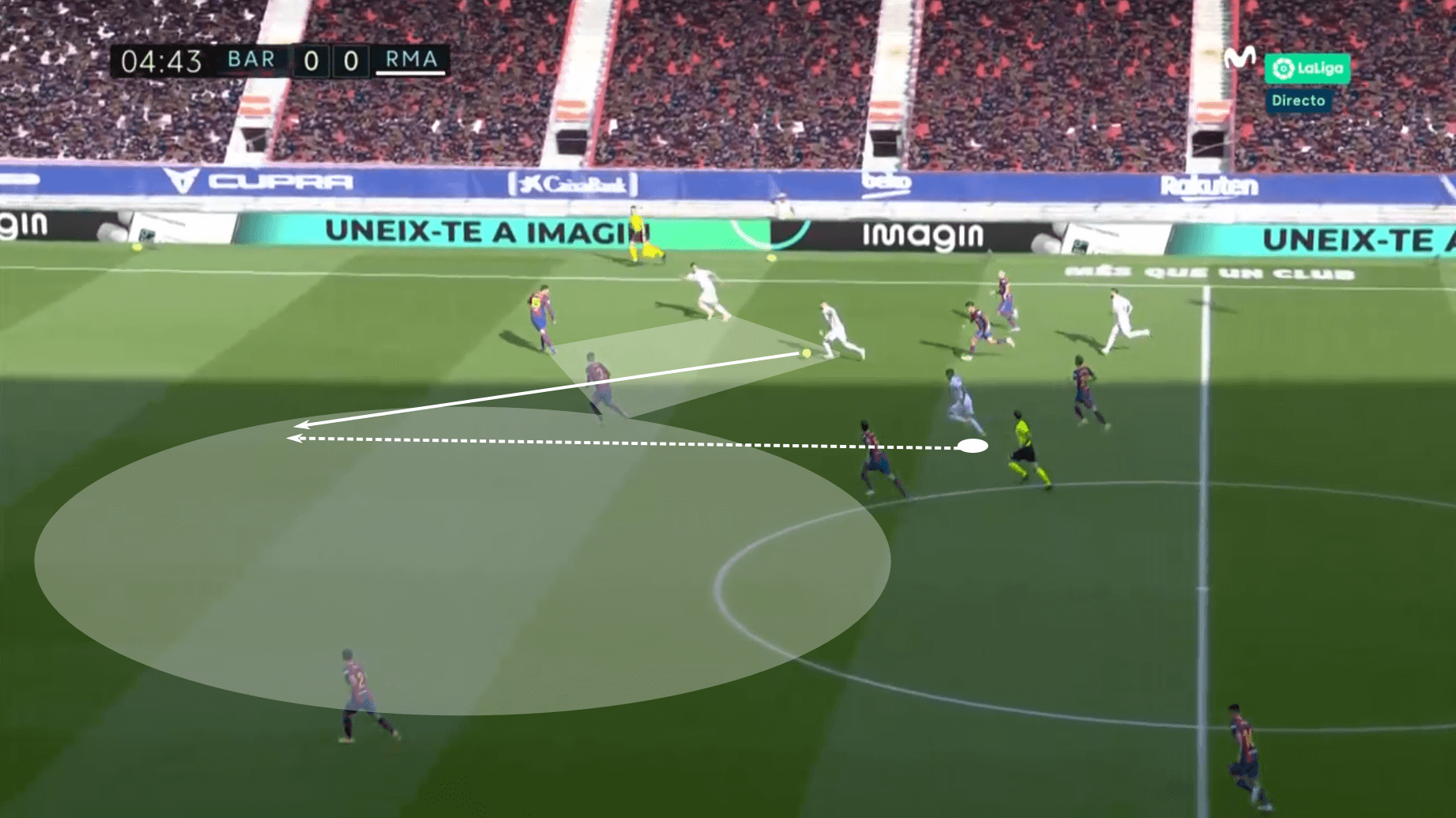
With Barcelona’s two outside-backs commonly positioned high and wide prioritising their attacking contributions, Real Madrid looked to attack the spaces they vacated, particularly on the left-hand side through Vinícius Júnior. The young Brazilian has hurt them many times in the past and will likely be key to Real Madrid’s fate this weekend.
If Los Blancos can find success playing into the wide forwards, be it in the wings or half spaces, they’ll test the centrebacks’ mobility and their defensive work in space. That will pose problems for Barcelona as it’s an area opponents have attacked all season. In the image below, we see Real Sociedad looking for progression through the left half space. De Jong does well here, but he’s certainly not the player Real Madrid will look to target with those quick switches and through balls to the left.
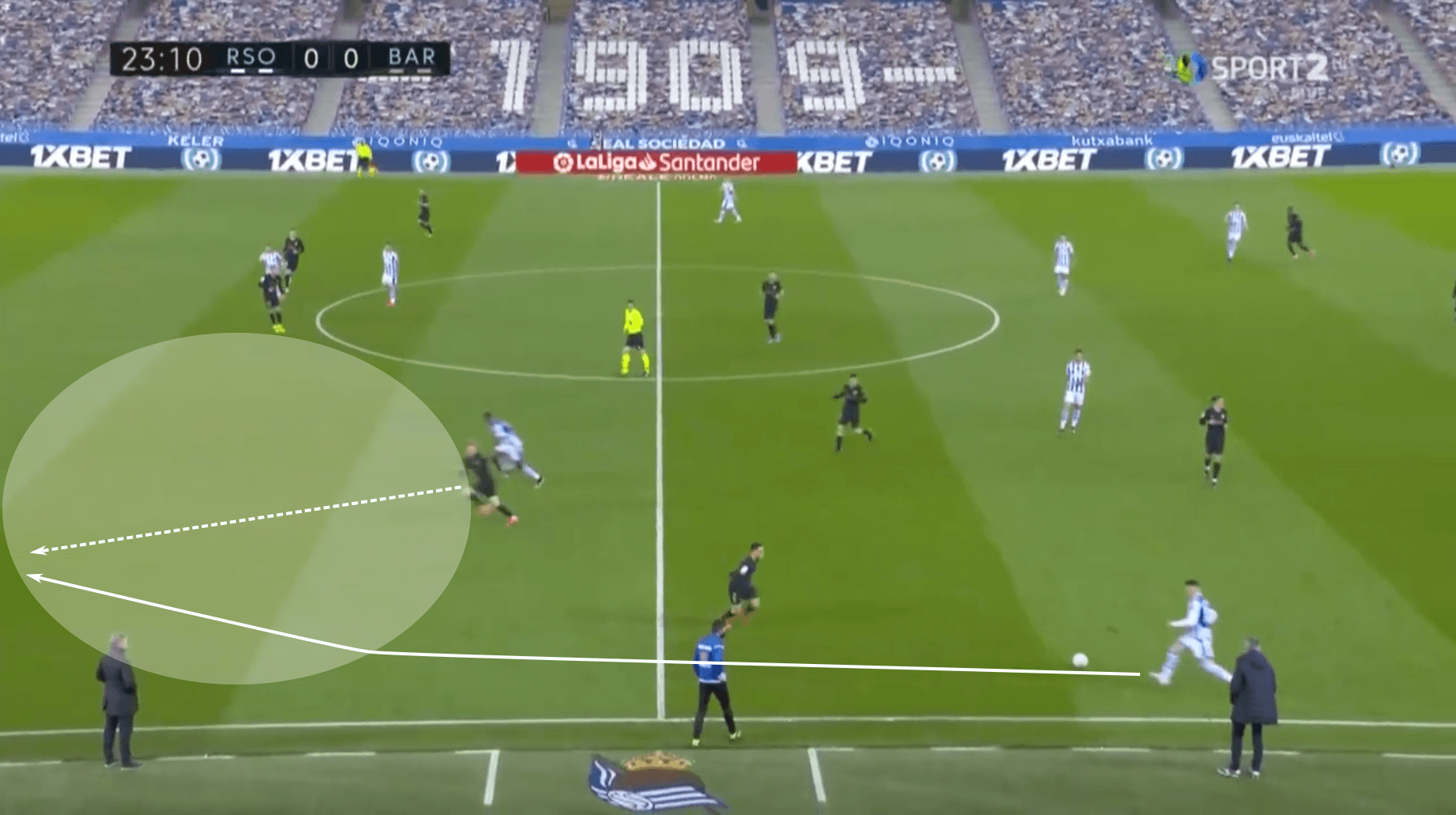
If Real Madrid can force Barcelona’s centrebacks to defend without coverage in the half spaces and wings, look for the remaining forwards and the trailing midfielder to aggressively attack the box in search of a finish. Barcelona has struggled to defend the wings against top opposition, so expect Zidane to prioritise this means of progression in his attacking tactics.
A suffocating middle block
Though Real Madrid isn’t shy about engaging in the high press, expect them to prioritise a middle block in El Clásico. When they do press high up the pitch, the tactics will likely mirror what we saw against Liverpool. The two wide forwards will drop deep and look to keep the outside-backs in front of them. Kroos and Modrić will press underneath Benzema to complicate the buildup through the central channel. If successful, that’ll force Barcelona to play into the outside-backs while eliminating their passing lanes for progression. Additionally, it will put the onus on the outside-backs to operate as the team’s playmakers, over committing them in attack.
Once Real Madrid has funnelled play into the outside-backs, the wide forwards will play a key role in forcing the outside-backs into early passes. The midfielders, especially Casemiro, will then look to intercept any passes returning to the half spaces or central channel.
One such example comes to us from the Liverpool game. As the ball arrived at Trent Alexander-Arnold’s feet, Vinícius Júnior was quick to close him down, forcing the Englishman to play centrally to Fabinho with one touch. Casemiro, who initially tracked Naby Keïta, was fully aware of TAA’s intention and picked off the pass.
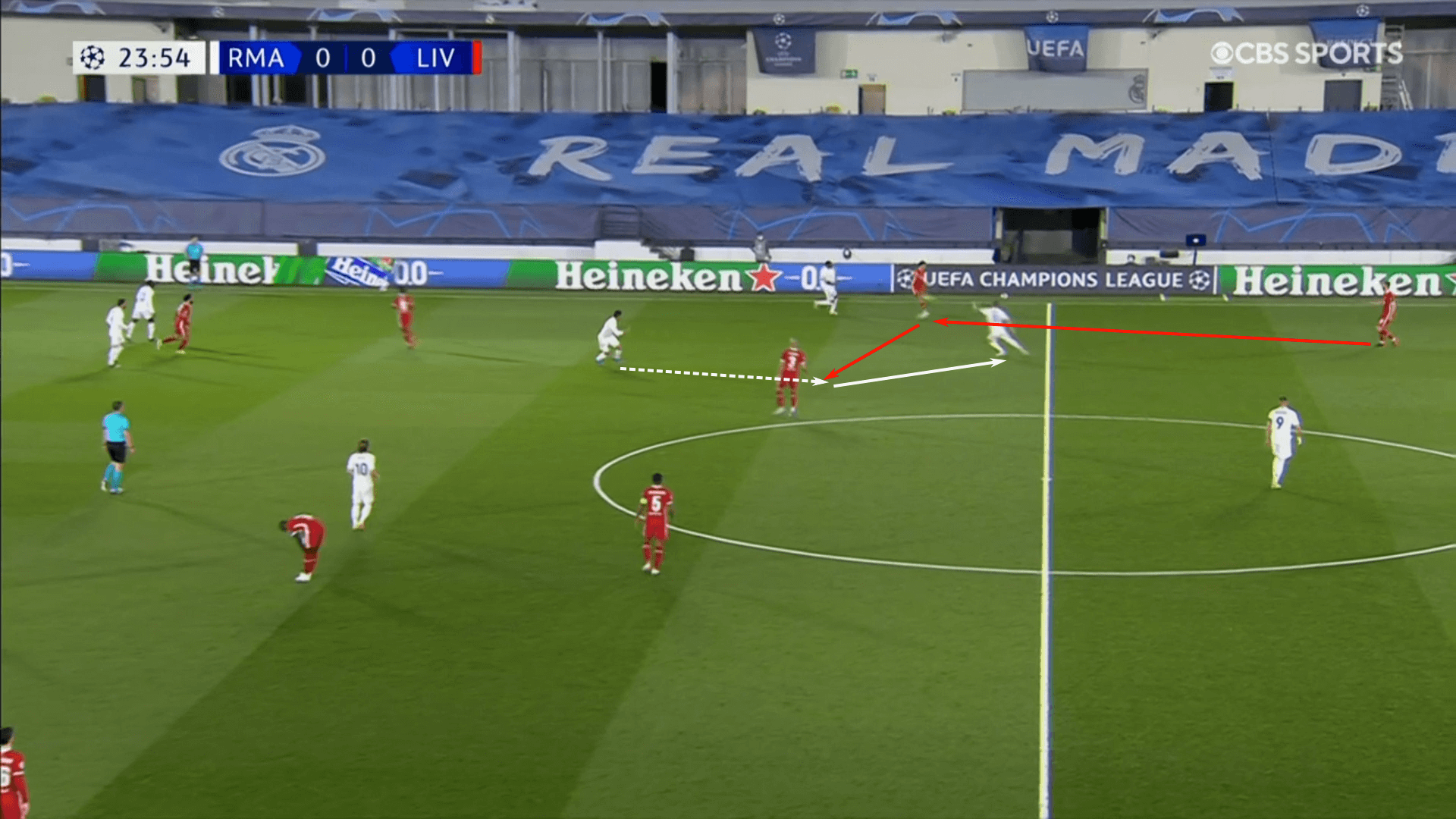
One of the added benefits of Kroos pushing up higher in the press is that when Real Madrid wins the ball they can immediately target him. As we see in this example, he’s not only clear of defenders but he has time to turn upfield and attack the half space through Benzema. He also had Vinícius Júnior running into the wing, which commanded the attention of Nathaniel Phillips.
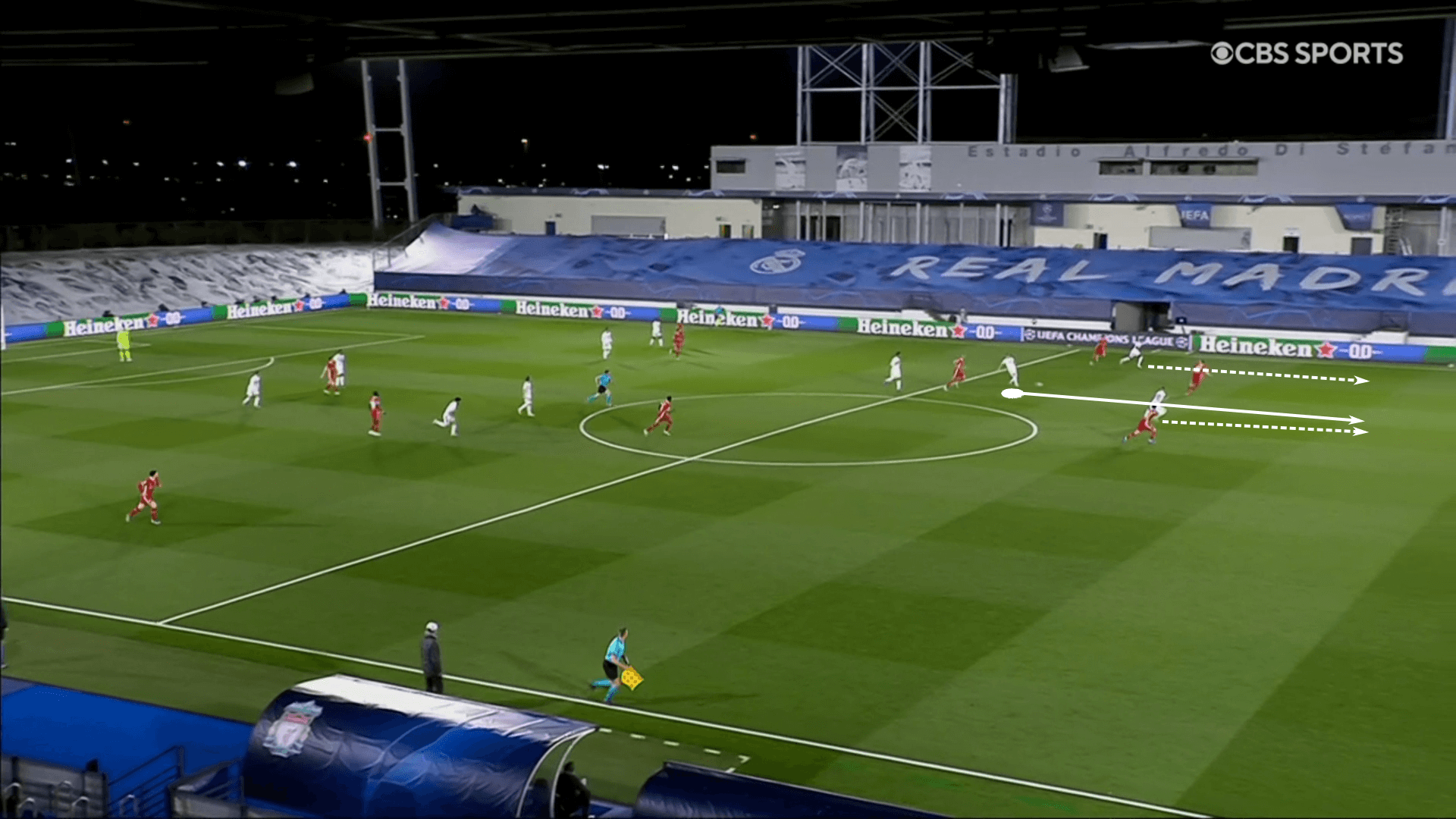
Recoveries in the middle block have the potential to unlock the Barcelona defence and create scoring opportunities. If Real Madrid can funnel play into the wings and adequately pressure the outside-backs, they’ll have their chances to counterattack against a poorly structured Barcelona rest defence.
If they are unable to keep Barcelona in the wings, the middle block has shown some vulnerability to balls played over the top. In March of 2020, Barcelona used the central overload of the forwards and distributions from the central channel to play behind Real Madrid’s backline. Griezmann and De Jong started high, but then checked to the ball. Before their movements, Real Madrid’s backline was well structured.
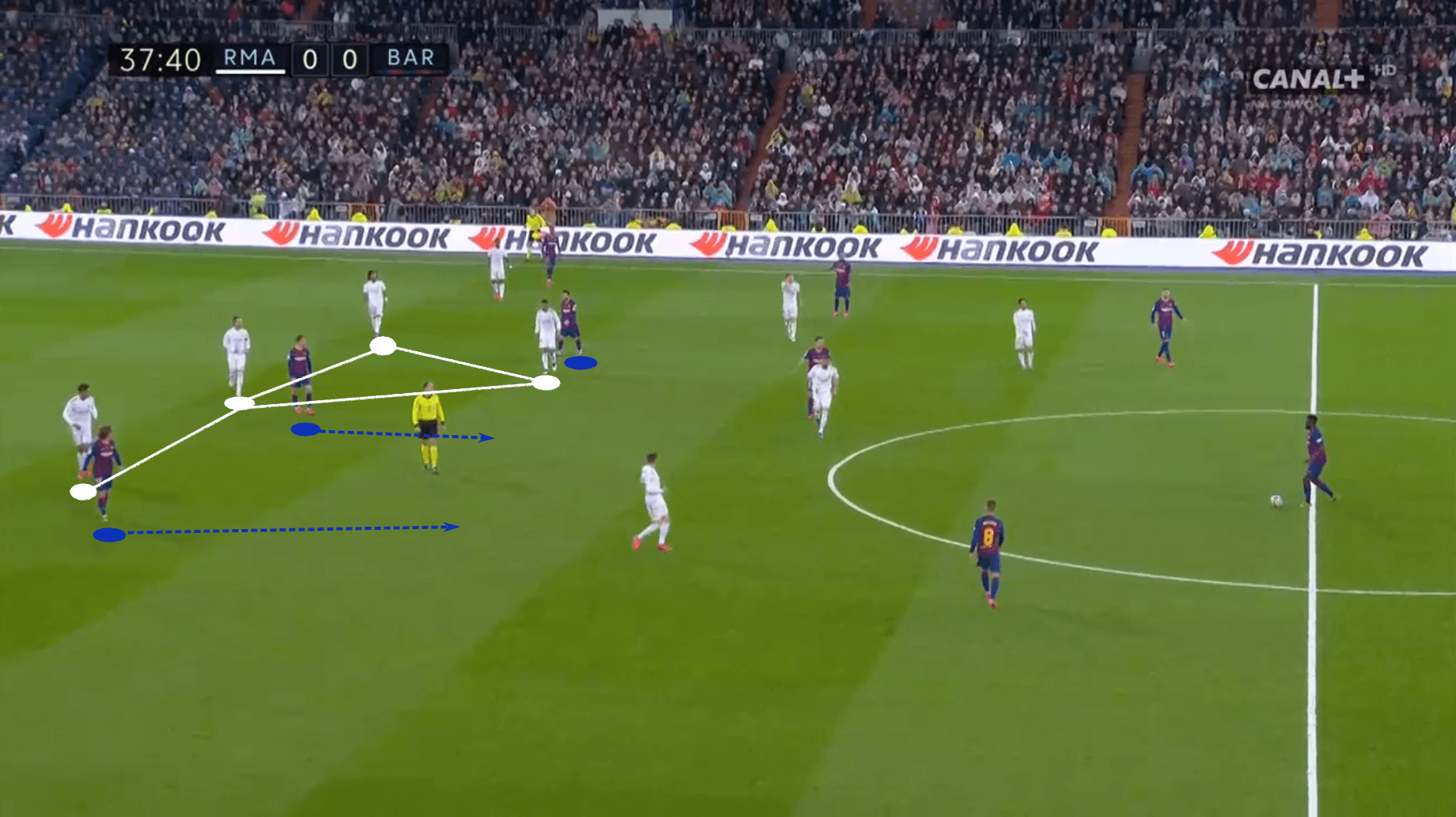
However, as our image below shows, Sergio Ramos and Raphaël Varane bit on the movements, checking into midfield, which allowed Messi to make his run behind them.
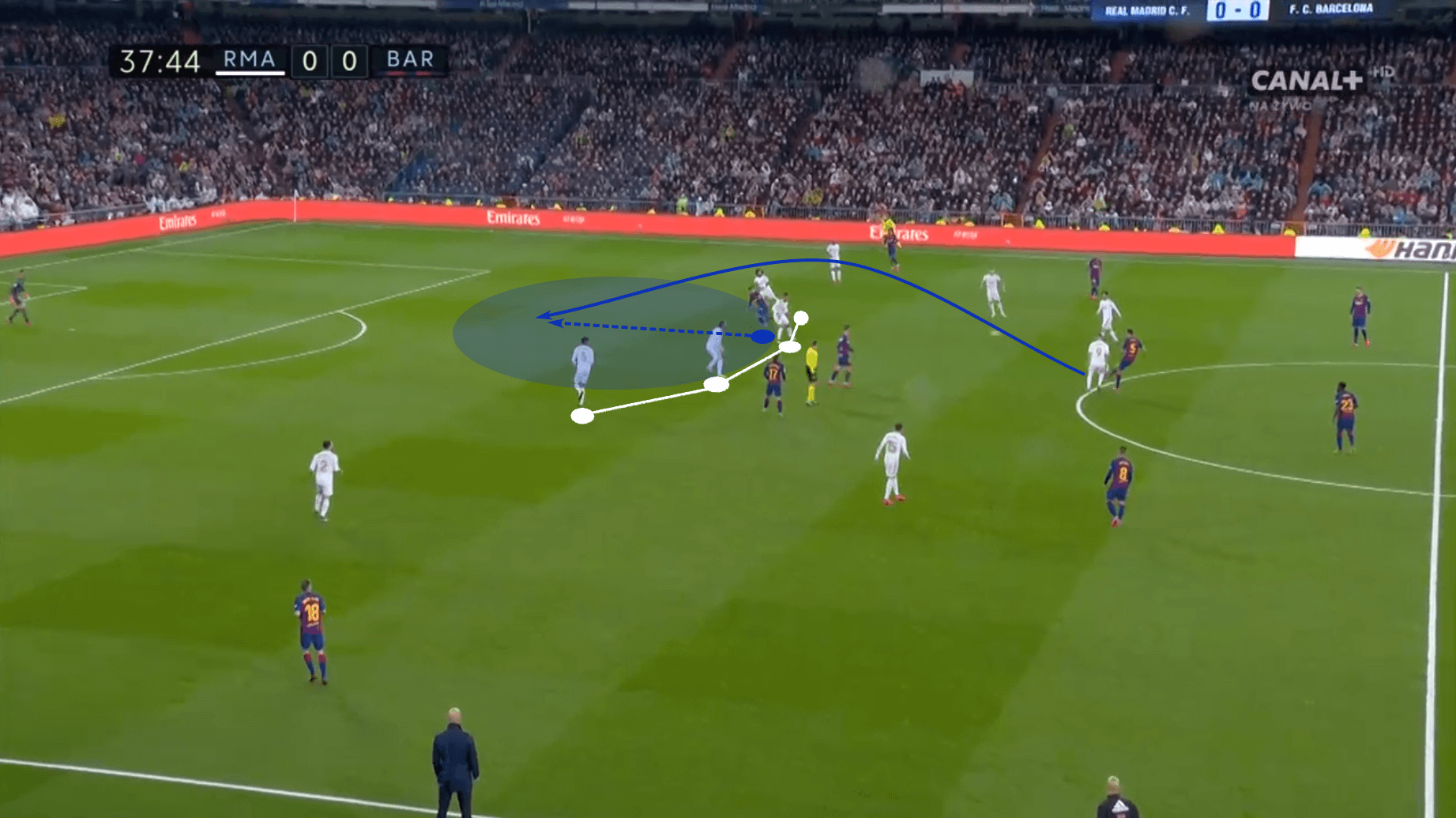
As Real Madrid sets up in the middle block, they will have to pay special attention to the coordinated movements of Barcelona’s forwards in that high central overload. Kroos and Modrić must find the right balance between pressing underneath Benzema and dropping deeper to support Casemiro. Nacho and Militão will have to play more conservatively knowing that, as the Barcelona forwards check into midfield, the objective is not necessarily to play the ball between the lines. If the centrebacks bite, the pass will go into the spaces they vacated, likely into the path of a certain #10.
Conclusion & final predictions
It’s always difficult to predict the result of a Clásico, especially in a season as turbulent as this one has been so far. However, if there’s one thing these two teams guarantee whenever they meet each other then it’s fireworks. With both Barcelona and Real Madrid in good form and coming off of a victory in their last game, they’ll be ready to beat their biggest rivals once more.
After all, with such small margins between them on the table, this could indeed be a season-defining clash of titans.
The winner might just take it all.






Comments